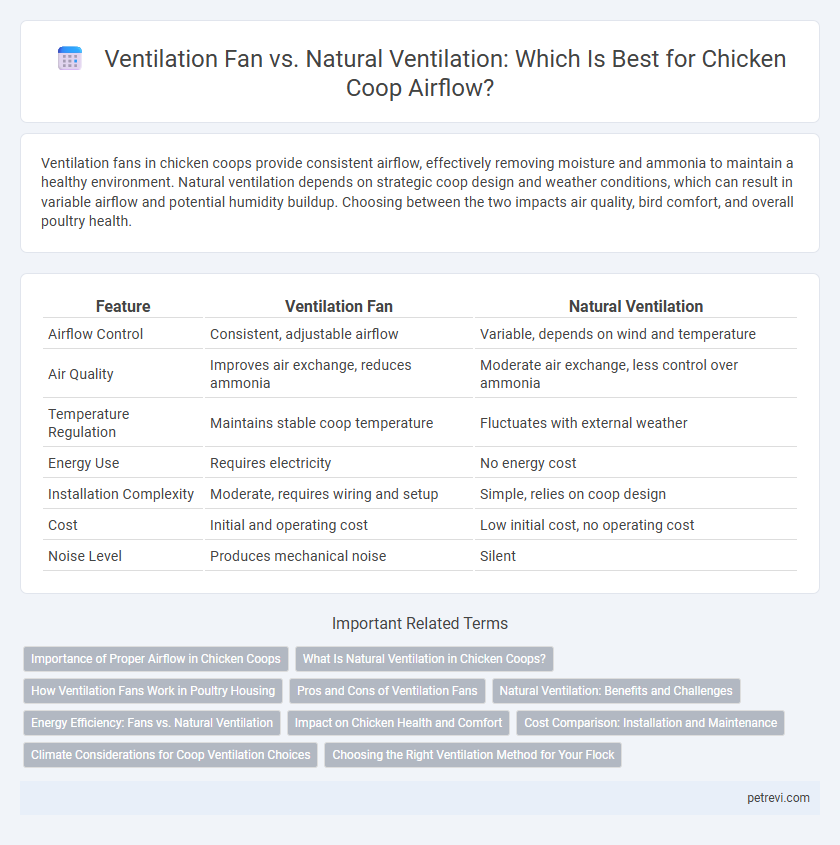Ventilation fans in chicken coops provide consistent airflow, effectively removing moisture and ammonia to maintain a healthy environment. Natural ventilation depends on strategic coop design and weather conditions, which can result in variable airflow and potential humidity buildup. Choosing between the two impacts air quality, bird comfort, and overall poultry health.
Table of Comparison
| Feature | Ventilation Fan | Natural Ventilation |
|---|---|---|
| Airflow Control | Consistent, adjustable airflow | Variable, depends on wind and temperature |
| Air Quality | Improves air exchange, reduces ammonia | Moderate air exchange, less control over ammonia |
| Temperature Regulation | Maintains stable coop temperature | Fluctuates with external weather |
| Energy Use | Requires electricity | No energy cost |
| Installation Complexity | Moderate, requires wiring and setup | Simple, relies on coop design |
| Cost | Initial and operating cost | Low initial cost, no operating cost |
| Noise Level | Produces mechanical noise | Silent |
Importance of Proper Airflow in Chicken Coops
Proper airflow in chicken coops is crucial to maintain a healthy environment that reduces ammonia buildup, controls humidity, and prevents respiratory diseases in chickens. Ventilation fans actively circulate air, ensuring consistent exchange and reducing stagnant zones, while natural ventilation relies on strategically placed vents and openings to promote airflow through wind and temperature differences. Optimizing ventilation methods enhances bird comfort, growth rates, and overall flock productivity by maintaining optimal air quality and temperature conditions.
What Is Natural Ventilation in Chicken Coops?
Natural ventilation in chicken coops relies on strategically placed openings and vents that utilize wind and temperature differences to circulate fresh air without mechanical assistance. This airflow method helps regulate humidity, reduce ammonia buildup, and maintain a healthy environment for chickens by promoting continuous air exchange. Properly designed natural ventilation systems minimize drafts while ensuring sufficient oxygen levels and temperature control inside the coop.
How Ventilation Fans Work in Poultry Housing
Ventilation fans in poultry housing actively control airflow by drawing fresh air into the chicken coop and expelling stale air, maintaining optimal temperature and humidity levels critical for bird health. These fans use adjustable speed settings and strategically placed inlets to ensure consistent distribution of oxygen while removing ammonia, moisture, and heat. Proper operation of ventilation fans enhances air quality, reduces respiratory diseases, and supports overall productivity in poultry management.
Pros and Cons of Ventilation Fans
Ventilation fans in chicken coops provide consistent, controllable airflow that effectively reduces humidity and ammonia buildup, promoting healthier respiratory conditions for poultry. These fans, however, require electricity and regular maintenance, which can increase operating costs and risk mechanical failure during power outages. Despite this, the ability to precisely regulate air exchange makes ventilation fans superior in environments with extreme temperatures or high stocking densities compared to natural ventilation.
Natural Ventilation: Benefits and Challenges
Natural ventilation in chicken coops leverages wind and temperature differences to promote airflow, reducing humidity and ammonia buildup and enhancing bird health. This method minimizes energy costs and maintenance compared to mechanical ventilation systems. However, its effectiveness depends on coop design, local climate, and wind patterns, potentially leading to inconsistent air exchange during calm or extreme weather conditions.
Energy Efficiency: Fans vs. Natural Ventilation
Ventilation fans in chicken coops offer controlled airflow that significantly improves energy efficiency by reducing the need for manual adjustments and maintaining consistent air quality. Natural ventilation relies on passive air movement through vents, which can be less energy-intensive but unpredictable and often insufficient during extreme weather conditions. Utilizing fans strategically can optimize energy use by providing targeted airflow only when necessary, while natural ventilation serves as a sustainable option with zero energy consumption under ideal conditions.
Impact on Chicken Health and Comfort
Ventilation fans in chicken coops provide consistent airflow that regulates temperature and reduces moisture, significantly lowering the risk of respiratory diseases and ammonia buildup harmful to chickens. Natural ventilation relies on passive airflow through windows and vents, which can be less effective in extreme weather, potentially leading to heat stress or damp conditions. Optimized fan systems improve air quality and comfort, enhancing poultry health and productivity compared to variable natural ventilation methods.
Cost Comparison: Installation and Maintenance
Installing a ventilation fan in a chicken coop typically incurs higher upfront costs, averaging $100 to $300 for equipment and professional setup, compared to natural ventilation which requires minimal installation expenses. Maintenance for fans includes electric costs, filter replacements, and potential repairs, often totaling around $50 to $100 annually, whereas natural ventilation relies on passive airflow and incurs negligible upkeep costs. Choosing between these options hinges on budget constraints and the desired control over coop airflow and temperature.
Climate Considerations for Coop Ventilation Choices
Ventilation fans provide consistent airflow, crucial in humid or hot climates to prevent heat stress and ammonia buildup in chicken coops. Natural ventilation relies on strategic placement of windows and vents, optimizing airflow based on prevailing wind patterns and is effective in moderate climates with stable temperatures. Climate-specific factors such as temperature fluctuations, humidity levels, and seasonal changes dictate whether mechanical fans or natural ventilation systems best maintain air quality and bird comfort.
Choosing the Right Ventilation Method for Your Flock
Choosing the right ventilation method for your chicken coop depends on factors like flock size, climate, and coop design. Ventilation fans provide consistent airflow and humidity control, making them ideal for larger flocks or extreme weather conditions. Natural ventilation, using windows and vents, offers energy-efficient airflow suitable for smaller coops in moderate climates, promoting healthy respiration and reducing ammonia buildup.
Ventilation Fan vs Natural Ventilation for Chicken Coop Airflow Infographic

 petrevi.com
petrevi.com